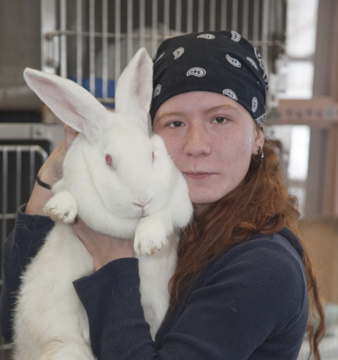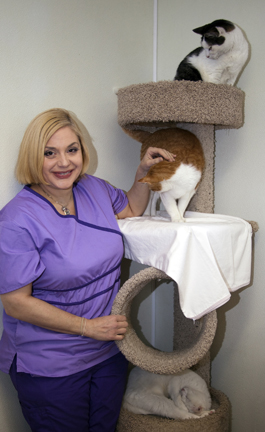The Animal Care Manager
On a cold snow-covered February morning, Cathy Naccio-Ford couldn’t sleep – fretting over the well-being of her animals. Rather than stare at the ceiling or pace the floors of her Pocono home, she got dressed and drove the hour to Easton’s Center for Animal Health and Welfare (CAHW). Arriving well before her usual 7:00 a.m. start time, Cathy began her day in typical fashion: walking the dogs, checking the special needs animals, feeding the animals and cleaning their living spaces. Cathy is the Animal Care Manager at CAHW, the area’s largest no-kill shelter.
Though Cathy’s early resume may suggest she’d be in an entirely different career at this point, Cathy isn’t remotely surprised at her position today. In fact, she’d be shocked if she were anywhere else. Growing up on Staten Island, Cathy’s parents had a lot of property but not a lot of money. Neighbors regularly dropped animals on the family’s grounds and each time Cathy’s father drove them to the local shelter. Devastated, Cathy rode along knowing the animal was on its way to be euthanized. From that early age Cathy knew it was her mission to one day work with shelter animals.
In a move that ultimately helped her attain her goal, Cathy became a paralegal at a Manhattan law firm, where she remained for 11 years. Eventually marrying a partner at the firm, Cathy finally gained the financial freedom to pursue her true calling. After eight years of volunteering at a shelter in New Jersey, Cathy became an animal control officer and worked at other shelters throughout the state, ultimately landing in Pennsylvania at CAHW five years ago. When asked why she chose CAHW Cathy simply replied “it’s huge and there are many more animals here that need me.”
The demonstration of unabashed love was heartwarming and clearly reflected in the cheerful dispositions of the dogs.
While “huge” may not describe the actual square footage, it does describe the volume of animals on site. Upon first entering the main building, visitors are greeted by front-desk personnel and two sweet residents, Rueben and Macie. Rueben is a senior Pekingese with special needs and Macie suffered neurological damage at the hands of her owner. Both now call the reception area home and although Rueben is available for adoption, both will probably live out the remainder of their lives showered with love and care at the front desk.
Off the reception area are several free-roaming rooms for cats (and rabbits), all of whom look strikingly vibrant with shiny coats, healthy weights and calm dispositions. With well over 80 feline residents, one room houses the cats in cages because the free-roam rooms are at capacity.
 Long before you reach the bottom step to the lower level it is abundantly clear what lies below: the dog kennels. Barking, barking and more barking could lead one to think he had inadvertently dressed as a Milkbone® that morning. It’s morning kennel-cleaning time as I walk through the canine area. Each dog is outside his or her temporary housing while the canine manager and her volunteers are happily hosing down the kennels and playing with the dogs. A particularly sweet couple of seniors, Pilaf and Tisha, have private quarters, a rare luxury reserved for older canines. Even as a dog-lover, the volume of “cleaning” was overwhelming to me, but each and every person working had a smiling face and oozed pure joy for the animals. The demonstration of unabashed love was heartwarming and clearly reflected in the cheerful dispositions of the dogs.
Long before you reach the bottom step to the lower level it is abundantly clear what lies below: the dog kennels. Barking, barking and more barking could lead one to think he had inadvertently dressed as a Milkbone® that morning. It’s morning kennel-cleaning time as I walk through the canine area. Each dog is outside his or her temporary housing while the canine manager and her volunteers are happily hosing down the kennels and playing with the dogs. A particularly sweet couple of seniors, Pilaf and Tisha, have private quarters, a rare luxury reserved for older canines. Even as a dog-lover, the volume of “cleaning” was overwhelming to me, but each and every person working had a smiling face and oozed pure joy for the animals. The demonstration of unabashed love was heartwarming and clearly reflected in the cheerful dispositions of the dogs.
Next stop, the “lower building,” which is really an old converted house. This is where all new animals are initially housed. Each animal goes through a thorough intake process including a complete physical, medical needs assessment, spay or neutering, vaccinations and the implementation of a microchip. The new arrivals remain quarantined for 10 days before moving to the “main house,” assuming space is available. Loud barking comes from a crate adjacent to the “operating room,” and Cathy lets the crate’s resident, Dandelion, out to greet us. And greet us she does! Dandelion races around the room full-tilt, stopping only to jump up and lick us before circling the room again. It’s hard to believe Dandelion, a young pit bull terrier mix, came to the shelter as a stray in early December with ribs showing, a broken femur and so shy she would only hover at one’s leg. Through private donations, Dandelion was able to have pins surgically placed in her leg, has gone through rehab and has been “loved back to health.” No longer suffering from malnutrition, or shyness, Dandelion is ready to be adopted.
By midday Cathy has checked on all the animals and will continue to administer medication, document test results from the prior day’s veterinarian visit, complete ID cards (of which there is one for each animal, documenting its care) and consult with and provide guidance to other employees and volunteers. As Animal Care Manager, Cathy is required to supervise people, but admits it’s her least favorite part of the job. She considers herself a caregiver but performs management functions because they are necessary and ensure the animals receive the best possible care.
Cathy confirms occupancy rates are higher due to the current economic climate but also admits that during her 16 years of working at shelters there has never been “enough room, enough money or enough volunteers.” When asked about basic statistics of the shelter -– occupancy, average length of stay, budget -– Cathy doesn’t know the answers. It’s not that she doesn’t realize the importance of that information; it’s just not part of her focus. Cathy’s responsibility is to care for the animals, no matter how they got there, what condition they arrived in or how long they stay. Cathy considers each animal at the shelter her own and finds it bittersweet when they leave. Although she remains far from jaded, Cathy knows that storybook endings are few and far between. Even when animals are adopted, too often they are returned to the shelter for one reason or another.
 “Today is a clean day so far,” Cathy says smiling. “Most days by now I’m covered in urine, feces and vomit. Today my knees are just wet from kneeling in the snow.” Of course it’s only 1:00 p.m. and a lot can happen between now and the time Cathy heads home sometime after 7:00 p.m.
“Today is a clean day so far,” Cathy says smiling. “Most days by now I’m covered in urine, feces and vomit. Today my knees are just wet from kneeling in the snow.” Of course it’s only 1:00 p.m. and a lot can happen between now and the time Cathy heads home sometime after 7:00 p.m.
Long after dark Cathy makes the one hour drive back home where she has a few pets, but not nearly as many as she used to. She has well over 3000 animals to care for during the course of a year at CAHW which is, sadly, more than enough.
The Center for Animal Health and Welfare is a private organization, not affiliated with any other SPCA or ASPCA. Ninety percent of the shelter’s income is made up of fund- raising, donations and bequests. For more information or to make a donation please visit www.healthyanimalcenter.org.





